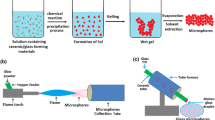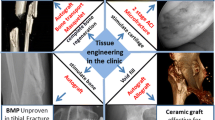Abstract
This paper presents a numerical model of a porous, hydroxyapatite-based bone graft also suitable as a drug delivery device. The graft was positioned in different sites and with different porosities inside a human femur model. The structural analyses were carried out to verify the graft mechanical strength, using the Tsai–Wu criterion, and the maximum porosity at which static failure does not occur. A local stress shielding risk was also calculated as the ratio between the bone stress in the intact condition and the stress after implantation of the graft. Drug release kinetics was calculated by means of the finite element method. High porosity grafts were found to fail in all implantation sites. Lower porosity grafts showed to have adequate strength if implanted in some positions, while provided insufficient resistance for other implantation sites. Drug release kinetics was found to be strongly dependent both on the porosity of the graft and the bone density near the bone-graft interface.
Similar content being viewed by others
References
Abdekhodaie MJ, Cheng YL (1997) Diffusional release of a dispersed solute from planar and spherical matrices into finite external volume. J Control Release 43: 175–182
Al Malyan M, Becchi C, Boncinelli S, Ashammakhi N (2007) Novel drug delivery systems in pain therapy. Minerva Anestesiol 73: 173–179
Ashammakhi N, Suuronen R, Tiainen J, Törmälä P, Waris T (2003) Spotlight on naturally absorbable osteofixation devices. J Craniofac Surg 14: 247–259
Buranapanitkit B, Srinilta V, Ingviga N, Oungbho K, Geater A, Ovatlarnporn C (2004) The efficacy of a hydroxyapatite composite as a biodegradable antibiotic delivery system. Clin Orthop Relat Res 424: 244–252
Charrière E, Terrazzoni S, Pittet C, Mordasini P, Dutoit M, Lemaitre J, Zysset P (2001) Mechanical characterization of brushite and hydroxyapatite cements. Biomaterials 21:2937–2945
Collins R, Jinuntuya N, Petpirom P, Wasuwanich S (1998) Mathematical model for controlled diffusional release of dispersed solute drugs from monolithic implants. Ann N Y Acad Sci 858: 116–126
Cristofolini L, Viceconti M, Cappello A, Toni A (1996) Mechanical validation of whole bone composite femur models. J Biomech 29: 525–535
Cristofolini L, Bini S, Toni A (1998) In vitro testing of a novel limb salvage prostheses for the distal femur. Clin Biomech (Bristol, Avon) 13: 608–615
Cyster LA, Grant DM, Howdle SM, Rose FR, Irvine DJ, Freeman D, Scotchford CA, Shakesheff KM (2005) The influence of dispersant concentration on the pore morphology of hydroxyapatite ceramics for bone tissue engineering. Biomaterials 26: 697–702
Higuchi T (1963) Mechanism of sustained action medication: theoretical analysis of rate of release of solid drugs dispersed in solid matrices. J Pharm Sci 1145–1149
Kao ST, Scott DD (2007) A review of bone substitutes. Oral Maxillofac Surg Clin North Am 19: 513–521, vi
Kokubo T, Kim HM, Kawashita M (2003) Novel bioactive materials with different mechanical properties. Biomaterials 24: 2161–2175
Kopperdahl DL, Keaveny TM (1998) Yield strain behaviour of trabecular bone. J Biomech 31: 601–608
Krajewski A, Ravaglioli A, Roncari E, Pinasco P, Montanari L (2000) Porous ceramic bodies for drug delivery. J Mater Sci Mater Med 11: 763–771
Lemaire V, Belair J, Hildgen P (2003) Structural modeling of drug release from biodegradable porous matrices based on a combined diffusion/erosion process. Int J Pharm 258: 95–107
Liu DM (1998) Preparation and characterization of porous hydroxyapatite bioceramic via slip-casting route. Ceram Int 24: 441–446
Liu H, Webster TJ (2006) Nanomedicine for implants: A review of studies and necessary experimental tools. Biomaterials 28: 354–369
Marshall EA, Windle DW (1982) A moving boundary diffusion model in drug therapeutics. Math Model 3: 341–369
McLaren AC (2004) Alternative materials to acrylic bone cement for delivery of depot antibiotics in orthopaedic infections. Clin Orthop Relat Res 427: 101–106
Medley JA, Andrews MW (1959) The effect of a surface barrier on uptake rates of dye into wool fibers. Text Res J 29: 398–403
Niebur GL, Yuen JC, Burghardt AJ, Keaveny TM (2001) Sensitivity of damage predictions to tissue level yield properties and apparent loading conditions. J Biomech 34: 699–706
Palazzo B, Sidoti MC, Roveri N, Tampieri A, Sandri M, Bertolazzi L, Galbusera F, Dubini G, Vena P, Contro R (2005) Controlled drug delivery from porous hydroxyapatite grafts: an experimental and theoretical approach. Mater Sci Eng C 25: 207–213
Patriarco AG (1992) Prediction of individual muscle forces during human movemen. PhD dissertation, MIT, Cambridge
Paul DR, McSpadden SK (1976) Diffusional release of a solute from a polymer matrix. J Membr Sci 1: 33–48
Peter B, Pioletti DP, Terrier A, Rakotomanana LR (2001) Orthopaedic implant as drug delivery system: a numerical study. Comp Meth Biomech Biomed Eng 4: 505–513
Pioletti DP, Gauthier O, Stadelmann VA, Bujoli B, Guicheux J, Zambelli PY, Bouler JM (2008) Orthopedic implant used as drug delivery system: clinical situation and state of the research. Curr Drug Deliv 5: 59–63
Rauschmann MA, Wichelhaus TA, Stirnal V, Dingeldein E, Zichner L, Schnettler R, Alt V (2005) Nanocrystalline hydroxyapatite and calcium sulphate as biodegradable composite carrier material for local delivery of antibiotics in bone infections. Biomaterials 26: 2677–2684
Seitz H, Rieder W, Irsen S, Leukers B, Tille C (2005) Three-dimensional printing of porous ceramic scaffolds for bone tissue engineering. J Biomed Mater Res B Appl Biomater 74: 782–788
Staples M, Daniel K, Cima MJ, Langer R (2006) Application of micro- and nano-electromechanical devices to drug delivery. Pharm Res 23: 847–863
Wan WK, Yang L, Padavan DT (2007) Use of degradable and nondegradable nanomaterials for controlled release. Nanomed 2: 483–509
Wu XY, Zhou Y (1997) Finite element analysis of diffusional drug release from complex matrix systems. I. Complex geometries and composite structures. J Control Release 49: 277–288
Wu XY, Zhou Y (1998) Finite element analysis of diffusional drug release from complex matrix systems. II. Factors influencing release kinetics. J Control Release 51: 57–71
Yao JQ, Laurent MP, Gilbertson LN, Crowninshield RD (2001) Effect of minimum load on the fluid uptake and wear of highly crosslinked UHMWPE total hip acetabular components. Wear 250: 140–144
Yoshikawa H, Myoui A (2005) Bone tissue engineering with porous hydroxyapatite ceramics. J Artif Organs 8: 131–136
Zhou Y, Chu JS, Zhou T, Wu XY (2005) Modeling of dispersed-drug release from two-dimensional matrix tablets. Biomaterials 26: 945–952
Author information
Authors and Affiliations
Corresponding author
Rights and permissions
About this article
Cite this article
Galbusera, F., Bertolazzi, L., Balossino, R. et al. Combined computational study of mechanical behaviour and drug delivery from a porous, hydroxyapatite-based bone graft. Biomech Model Mechanobiol 8, 209–216 (2009). https://doi.org/10.1007/s10237-008-0132-3
Received:
Accepted:
Published:
Issue Date:
DOI: https://doi.org/10.1007/s10237-008-0132-3




